Employee Layoff Statistics By Industries, Demographics and Region (2025)
Updated · Sep 23, 2025

Table of Contents
- Introduction
- Editor’s Choice
- Total Number of Employees Laid Off
- Largest Tech Layoff
- Mass Layoffs
- Total Number of Tech Employees Laid Off
- Tech Layoff By Industry
- Regional Employee Layoff Statistics
- Pharmaceutical Employee Layoff Statistics By Company
- Employee Layoff Demographics
- Start-Up Layoff Statistics
- The Effect of Layoffs
- Conclusion
Introduction
Employee Layoff Statistics: Employee layoffs became a defining theme as 2024 progressed, with companies across industries announcing workforce reductions of varying scales. Some organizations opted for small adjustments, cutting fewer than a hundred roles, while others made more drastic moves that displaced thousands of employees at once. These layoffs were driven by multiple factors, including cost-cutting measures, restructuring efforts, and the broader impact of global economic uncertainty.
The trend reflected not only shifts in corporate priorities but also the ongoing challenge of balancing profitability with employee retention. For many workers, the sudden job losses highlighted the fragility of employment in a fast-changing business environment, underscoring the need for both companies and individuals to adapt quickly to new realities.
This article attempts to analyse the employee layoffs statistics, and will discover how these have changed, and how these aforementioned factors might produce interesting insights about employment.
Editor’s Choice
- The United States tech sector already chopped off 206,102 jobs across 221 companies, with another 2,628 people bearing 60 days’ notice.
- Tech saw varying layoffs per month of 34,800 in January, 14,973 in February, 21,000+ in March and April, 23,745 in May, 36,438 in June, and a record 38,716 in July.
- Alphabet laid off 12,000 employees-their largest layoff ever-while Microsoft dismissed 10,000 workers amid slowing digital spending, recession fears, and AI-related restructuring.
- Over 50,000 BGTM jobs were lost during just three months by Amazon, Alphabet, Microsoft, and Meta.
- Intel laid off 24,000 employees in July 2025, representing 15% of its workforce, with the aim of bringing its headcount down to 75,000.
- UPS cut 20,000 jobs and closed 73 facilities as part of a US$3.5 billion cost-cutting plan.
- CSL let go of 12,000 workers, accounting for 15% of its workforce; TCS, on the other hand, went out with a bang in laying off its 12,000 workers, the biggest-ever layoff initiative.
- Approximately 90,000 tech jobs got chopped in California, being the highest in the United States. Meanwhile, over 40,000 jobs were lost in Seattle, aligned with restructuring endeavours at Microsoft and Amazon.
- Texas saw a 12% rise in layoffs, mainly in the oil and gas sector. Meanwhile, the South East saw the loss of 25,000 retail and hospitality jobs.
- According to the statistics, 61% of people between 18 and 34 speak of being anxious about layoffs, whereas only 30% of the 55-plus age group feel unprepared.
- 53% of workers learning only in high school were laid off compared to 36% of college graduates.
- Men face the risk of layoff 25% more than women; about 12% of men say they were laid off at least twice, while just 4% of women say so.
Total Number of Employees Laid Off
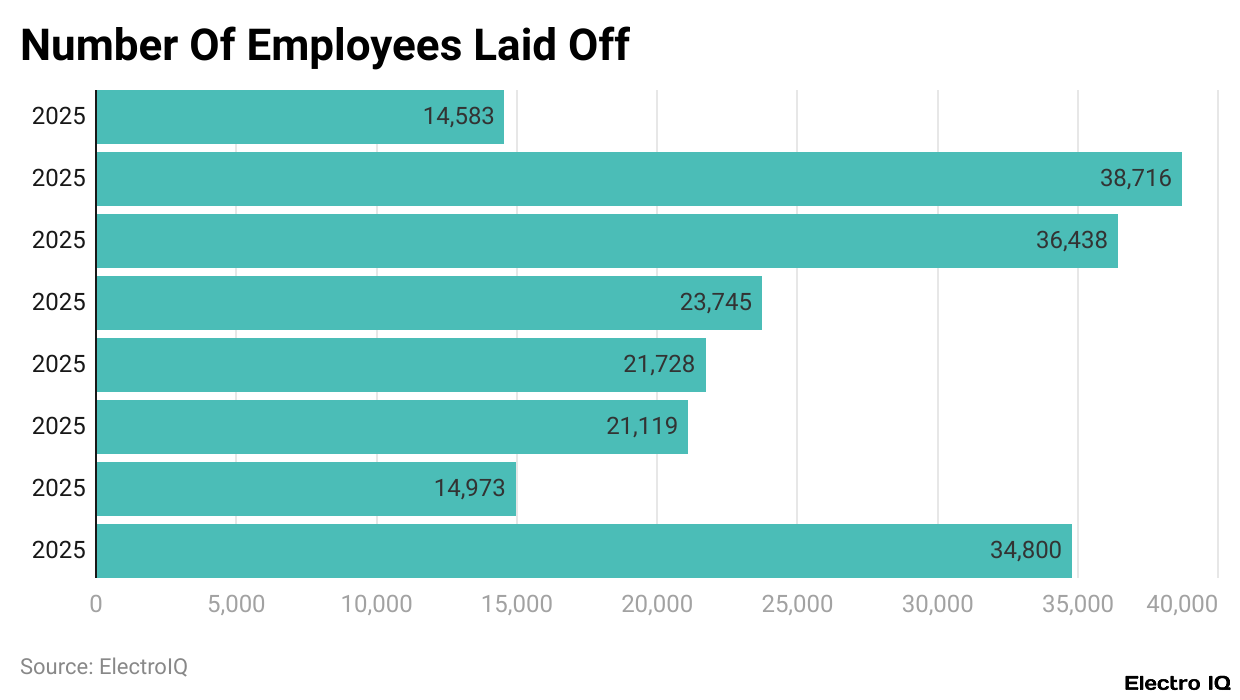
(Reference: demandsage.com)
- As per DemandSage, employee layoffs statistics show that in 2025 has already seen, in the United States, over 206,102 jobs given away across 221 companies, while 2,628 have been on notice periods of at least 60 days.
- Giving a month-wise breakup, the layoffs have witnessed an uneven trend, with pronounced spikes in some months.
- January saw the laying off of 34,800 jobs, which came down to 14,973 in February.
- Coming back in the first half of 2001, layoffs hovered around 20,000 in March and April, with a slight increase in May to 23,745, and June witnessed very tough months with job losses touching 36,438.
- The record so far was in July with 38,716 layoffs, and in August, that eased, but still, 14,583 layoffs happened.
- The outbreak and the trend shown in these figures confirm that layoffs in technology continue to be frequent and large, with spikes occurring due to direct causes in certain months.
Largest Tech Layoff
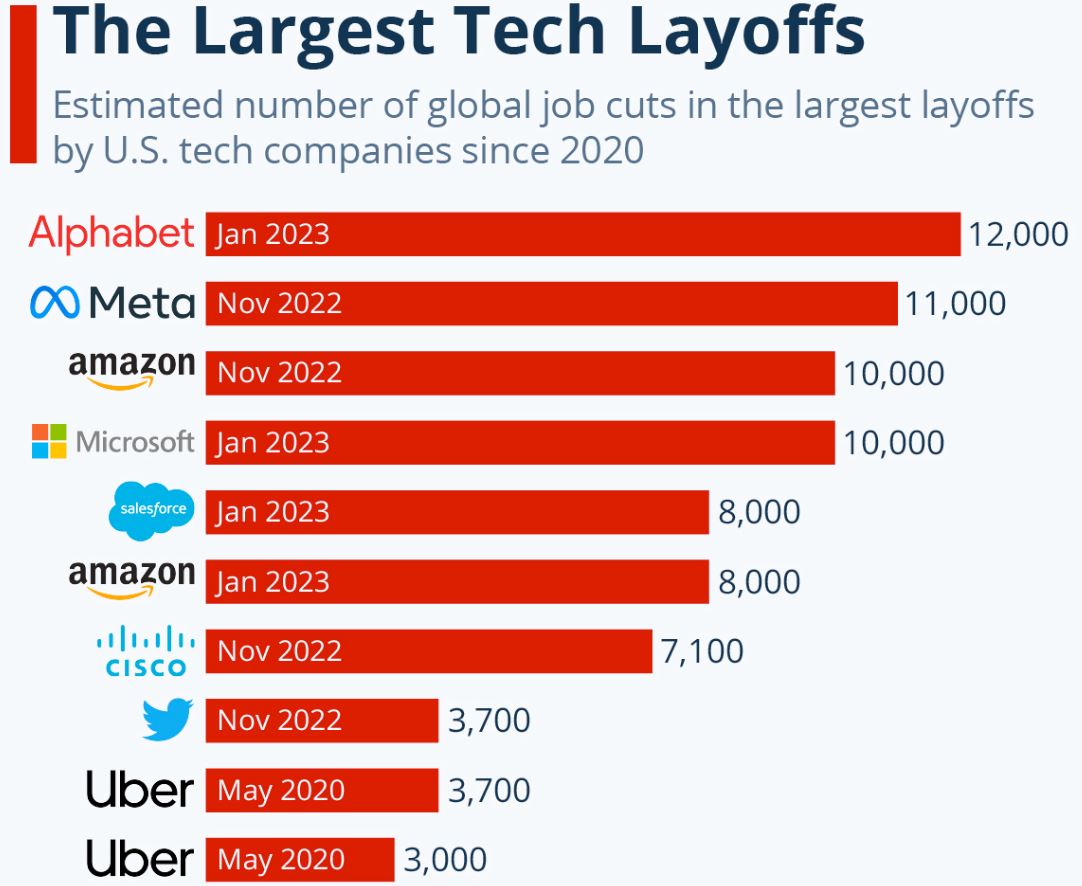
(Reference: statista.com)
- Recently, Microsoft and Alphabet, the parent firm of Google, announced extensive layoff plans to stay in step with the ongoing wave of tech layoffs.
- Microsoft said it would slash the size of its global workforce by 10,000 positions, while Alphabet announced the reduction of 12,000 jobs, the largest layoff in the company’s history.
- There is a common message Sundar Pichai shared with all his employees: The company had gone on a hiring spree during periods of rapid growth, but a very different economic environment is setting in.
- Alongside Nadella, Pichai pointed to AI as the next big wave of innovation and mentioned Google’s early bets in this space as giving it a good advantage for forthcoming opportunities.
- According to employee layoff statistics, this will be one of the largest job cuts in recent years.
- In just three months, more than 50,000 employees have been axed across Amazon, Alphabet, Microsoft, and Meta, with further layoffs anticipated throughout the tech industry.
Mass Layoffs
| Company Name | Employees Laid Off | Time Period | Industry |
| Intel | 24,000 | July 2025 | Technology |
| UPS | 20,000 | April 2025 | Delivery Services |
| CSL | 12,000 | August 2025 | Biotechnology |
| Tata Consultancy Services | 12,000 | July 2025 | Technology |
| Nissan | 11,000 | May 2025 | Transport |
| Blusmart | 10,800 | May 2025 | Transport |
| USPS | 10,000 | March 2025 | Logistics & Supply Chain |
| Intel | 10,000 | June 2025 | Technology |
| Microsoft | 9,000 | July 2025 | Technology |
| Hudson’s Bay | 8,300 | May 2025 | Retail |
| DHL | 8,000 | March 2025 | Logistics & Supply Chain |
| Chevron | 8,000 | February 2025 | Automobile |
| BP | 7,700 | January 2025 | Energy & Utilities |
| Procter & Gamble | 7,000 | June 2025 | Consumer Products |
| Audi | 7,500 | March 2025 | Automobile |
| Volkswagen | 7,000 | April 2025 | Automobile |
| Estée Lauder | 7,000 | February 2025 | Consumer Products |
| Microsoft | 7,000 | May 2025 | Technology |
| The United Nations Secretariat | 6,900 | May 2025 | Government |
| Siemens | 5,600 | March 2025 | Conglomerate |
| Chiquita Brands | 5,000 | May 2025 | Distribution |
| Petronas | 5,000 | June 2025 | Oil & Gas |
| The United States Cellular Corp | 4,100 | April 2025 | Telecommunication |
| Gazprom | 4,100 | January 2025 | Energy & Utilities |
| Telefonica | 4,000 | May 2025 | Telecommunication |
| Commerzbank | 3,900 | February 2025 | Banking |
| Meta | 3,600 | January 2025 | Technology |
| Dentsu | 3,400 | August 2025 | Media & Entertainment |
| Pemex | 3,000 | May 2025 | Energy |
| Sainsbury’s | 3,000 | January 2025 | Retail |
| Paramount | 3,000 | August 2025 | Media & Entertainment |
| STMicroelectronics | 2,800 | April 2025 | Manufacturing |
| Wicresoft | 2,800 | April 2025 | IT Services & Outsourcing |
| Hewlett Packard | 2,000 | February 2025 | Technology |
| Santander UK | 2,000 | July 2025 | Financial Services |
| Toronto Dominion Bank | 2,000 | May 2025 | Banking |
| Morgan Stanley | 2,000 | March 2025 | Financial Services |
| Johns Hopkins University | 2,000 | March 2025 | Education |
| Porsche | 1,900 | February 2025 | Automobile |
| Workday | 1,750 | February 2025 | Technology |
| Amazon | 1,700 | January 2025 | Retail |
| Burberry | 1,700 | May 2025 | Consumer Goods |
| Gazprom | 1,600 | January 2025 | Energy & Utilities |
| Walmart | 1,500 | May 2025 | Retail & eCommerce |
| PwC | 1,500 | May 2025 | Financial Services |
| Dow | 1,500 | January 2025 | Chemicals & Fertilizers |
| Blue Origin | 1,400 | February 2025 | Aviation |
| Goldman Sachs | 1,395 | March 2025 | Financial Services |
| Indeed and Glassdoor | 1,300 | July 2025 | Technology |
| Bell Canada | 1,200 | February 2025 | Telecommunication |
| Clarks | 1,200 | July 2025 | Consumer Goods |
| Moët Hennessy | 1,200 | April 2025 | Consumer Products |
| International Paper Co. | 1,100 | August 2025 | Manufacturing |
| Starbucks | 1,100 | February 2025 | Restaurant & Food Service |
| Bosch | 1,100 | July 2025 | Automobile |
(Source: demandsage.com)
- In 2025, being another large-scale layoff year, this is spurred mainly by restructurings and cost-saving measures.
- Intel tops the list with a record layoff of 24,000 employees in July, roughly 15% of its workforce, with the company aiming to hit a 75,000 total headcount by the end of 2026.
- UPS, the famous American logistics company, fired 20,000 people and shut 73 facilities under a US$3.5 billion cost-saving plan.
- CSL went one step further in sacking workers to the tune of 15% of the workforce, equal to some 12,000 employees, and shutting down 22 U.S. centres that underperformed.
- Likewise, TCS (Tata Consultancy Services) announced its greatest layoff ever in July, throwing out 12,000 middle- and senior-level employees in an effort to reorient for efficiency through artificial intelligence.
Total Number of Tech Employees Laid Off
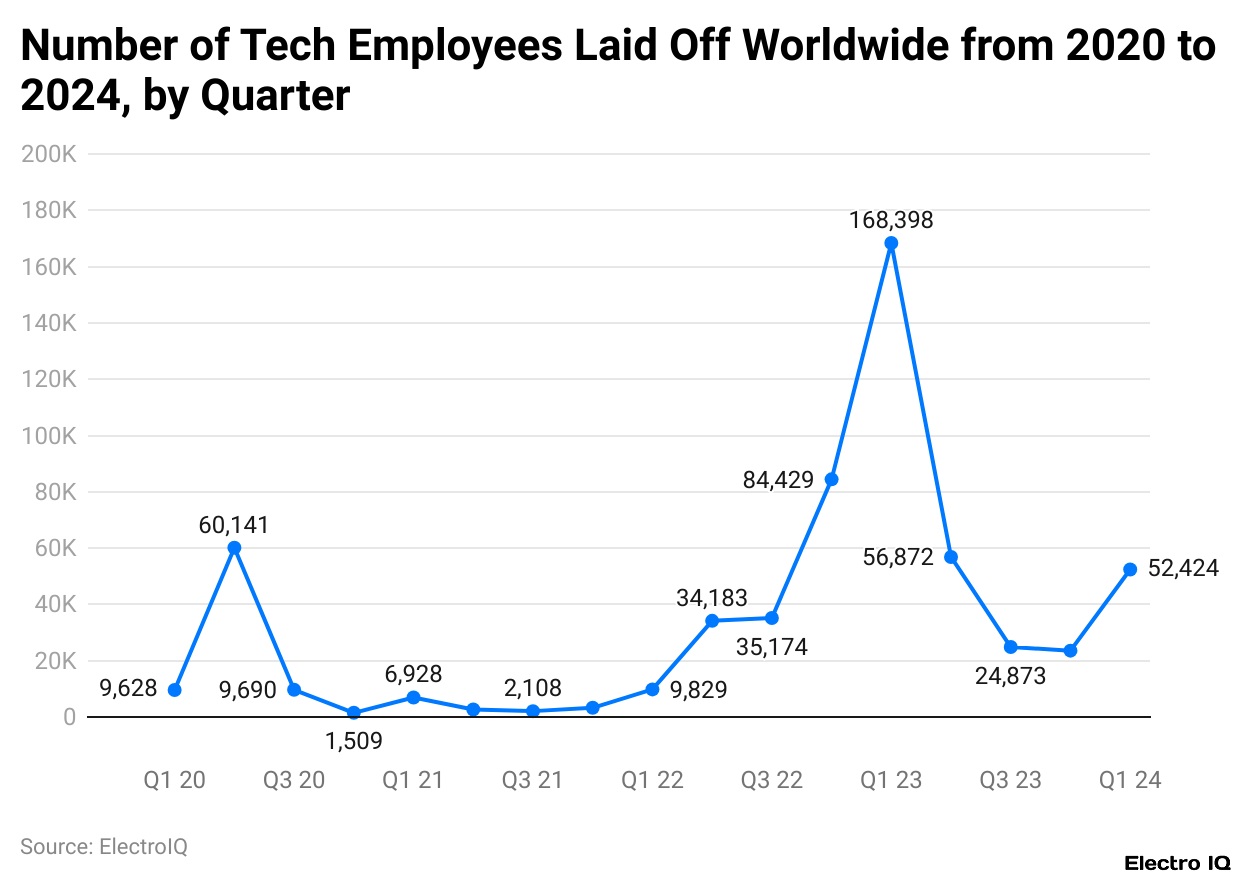
(Reference: sci-tech-today.com)
- According to a Statista report on employee layoffs statistics, the year 2023 witnessed lots of layoffs carried out across the globe in tech companies, most of them occurring early on.
- There have been almost 168,398 employees who were laid off in the first quarter alone, marking the figure tops by far.
- Then the pace drastically slowed down, dropping to 56,872 in the second quarter, 24,873 in Q3, and 23,588 in the fourth quarter.
- This means that there were big cutbacks in the workforce at the start of the year; however, in the following months, things tapered down as companies had made pretty big adjustments.
- The progressing trend, albeit with lower intensities, witnessed the severance of 52,424 tech employees worldwide in Q1 of 2024, further indicating a road downhill after the peak seen early in 2023.
Tech Layoff By Industry
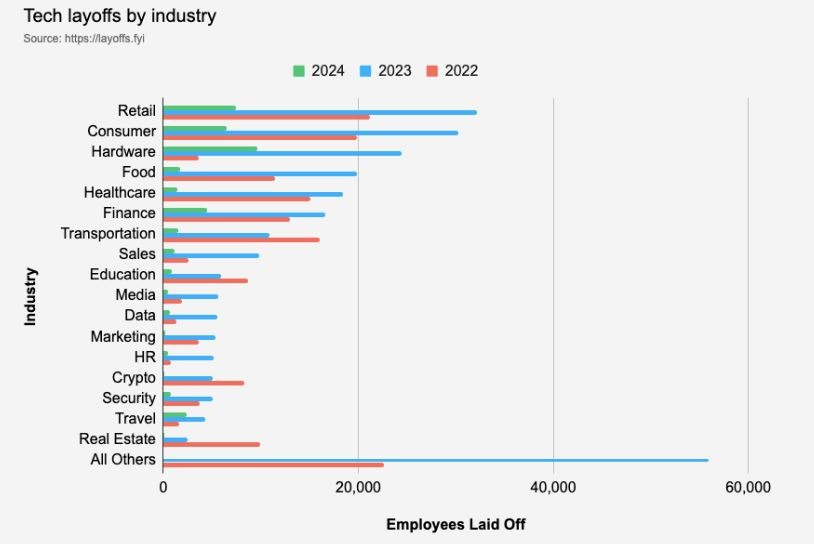
(Reference: sci-tech-today.com)
- A Statista analysis showed that massive layoffs hit multiple industries around the world.
- The globe saw about 32,000 job losses in 2023 in retail, with the consumer sector seeing over 30,000 job cuts, while the hardware sector saw 24,000 plus layoffs.
- Technology was the hardest hit during the first quarter of 2023 when giants such as Google, Meta, Microsoft, and IBM let go of some 167,400 employees.
- Healthcare accounted for 10.5% of the total number of job dismissals; SaaS companies followed with 10.1%, and finance came in at 9.5% when estimated across all industries for the distribution of layoffs in 2023.
- The lowest job cuts occurred in education, robotics, and social sectors, respectively, to 0.7% of total employee layoffs, denoting job cuts primarily in technology and large-scale consumer industries.
Regional Employee Layoff Statistics
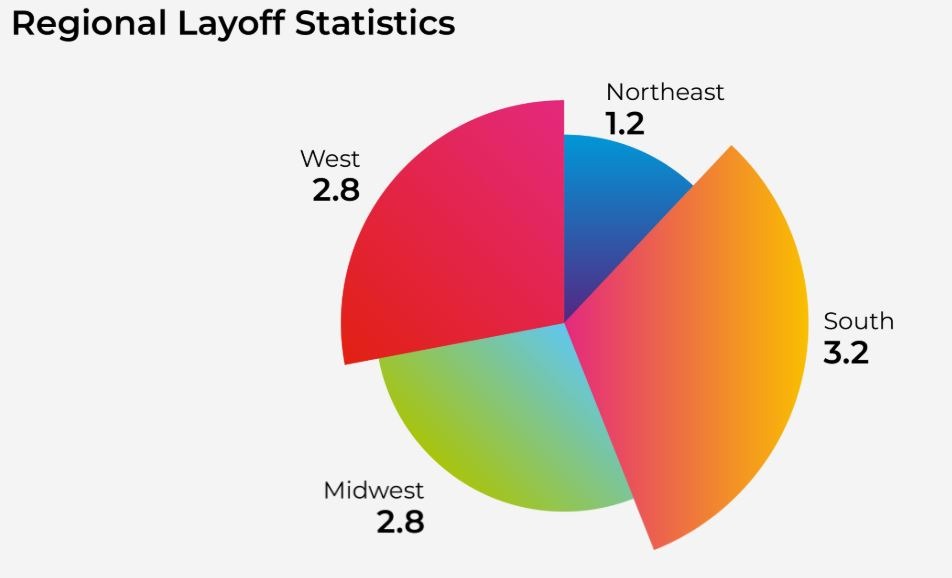
(Reference: market.biz)
- As per Market Biz, employee layoffs statistics show that regions across the United States underwent massive layoffs throughout the year 2024, though the industries affected stood in contrast.
- The Northeast pure search in excess of 60,000 job losses all within the realm of tech and finance, ranging throughout New York and Boston.
- California recorded the most dismissals seen, some 90,000 tech workers in Silicon Valley losing their jobs as a reaction by companies to global economic uncertainty and automation.
- In the Midwest, some 50,000 layoffs mainly occurred in Michigan, Ohio, and Illinois, with manufacturing plants either closing down or scaling down their automotive plants.
- With energy consumption changing across the termini of layers and lesser fossil fuel demand cutting into employment levels, layoff incidents in Texas shot up by 12% during the period under review, predominantly in oil and gas.
- More than 25,000 workers were laid off in the retail and hospitality industries across the Southeast, largely in Florida and Georgia, in the wake of shifting consumer behaviour and economic pressures.
- Southern California accounted for some 35,000 job losses in entertainment and media, as film studios and production houses partly scaled back while transitioning toward a digital-first business environment.
- Tech hit the Pacific Northwest hard, with job losses in excess of 40,000 in Seattle alone, in line with major restructuring at giants such as Microsoft and Amazon.
- Tourism and hospitality in Florida set the stage for an additional 10,000 job losses, marking wobbliness in travel demand as the post-pandemic recovery waned.
- Around 15,000 layoffs were reported in industries and agriculture-related manufacturing in the Great Plains, including Kansas and Nebraska.
- Meanwhile, Mountain West-area states, including Colorado and Arizona, suffered roughly 8,000 energy layoffs and mining layoffs because of unstable energy prices and policy changes.
- The traditional industries of the Rust Belt, which extended in areas of Pennsylvania, Ohio, and West Virginia, had manufacturing layoffs increase by 10%.
Pharmaceutical Employee Layoff Statistics By Company
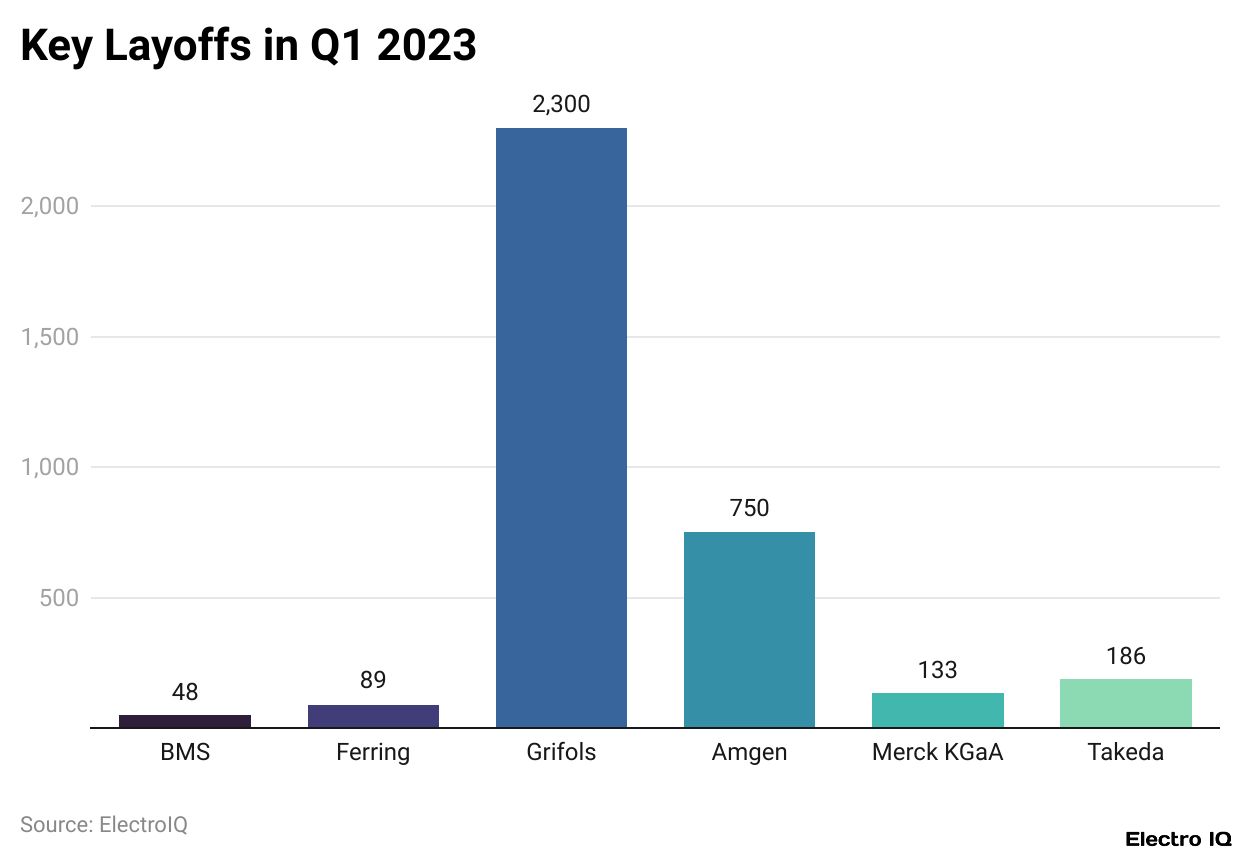
(Reference: sci-tech-today.com)
- Putting Grifols at the top of the list concerning layoffs in the first quarter of 2023, where it would have laid off around 2,300 employees.
- Disseminating, along with that single largest layoff event induced by Grifols, were also other smaller job cuts from several other pharmaceutical companies.
- Among these, Amgen had downsized by 750 employees, Takeda let go of 186, Merck KCA 133, Ferring 89, and BMS (Bristol Myers Squibb) 48.
- It is thus clear that while Grifols had the largest individual layoff, many other pharmaceutical companies contributed to the downsizing trend during this period.
Employee Layoff Demographics
- Layoffs affect people differently, depending on age, gender, and education levels.
- The youngest workers, between the ages of 18 and 34, claim to feel the most stress: approximately 61% admit to layoff anxiety, and 51% confess to not feeling prepared in case one might actually occur.
- On the other hand, 41% of adults over 35 experience layoff anxiety, while 30% of those above 55 years consider themselves unprepared in the case of job loss.
- Only about 36% of workers holding a college degree have been laid off, whereas percentages are far greater for those without such credentials.
- Approximately 53% of those with only a high school diploma and about 52% of those who have attended college for some time without earning a degree say they have experienced layoffs.
- And for gender, there are also differences. Close to 45% of the men said they had been laid off, compared to 36% of the women.
- Men are estimated to be 25% more likely than women to experience job loss.
- Men also differ from women with respect to how often they were laid off: 12% of them said they had been laid off more than twice, whereas only 4% of the women reported the same.
- Taken together, these statistics suggest workers in the younger category feel anxious about the situation, those less educated feel more vulnerable, and men are laid off more often and more repeatedly compared to their female counterparts.
- Across all industries, 45.7 per cent of all employees say they feel ill-prepared in handling the experience of being laid off.
Start-Up Layoff Statistics
- More than 100,000 jobs were cut by U.S. startups in 2024, a sharp increase from previous years. Economic realities and declining venture capital funding were cited most of the time.
- Tech startups represented close to 15% of all layoff announcements, with companies such as Stripe, Plaid, and Gusto laying off thousands of workers to optimise operations.
- Layoffs in fintech increased by 10% as smaller startups fought to raise capital and compete with big financial firms.
- Health-tech startups cut staff by about 15% as they face regulatory hurdles and slower market growth. AI and automation startups have caused 20% of layoffs since these are usually targeted at replacing manual jobs.
- SaaS companies accounted for 18% of layoffs, reacting to subscription changes and pressure to show profits.
- The job cutting has increased by 12% in this segment because of weaker customer spending and more robust competition from large companies.
- Biotech start-ups, meanwhile, laid off 10% of their workforce, mainly in response to setbacks in clinical trials and product development.
- About 70% of all layoffs took place in tiny start-ups with less than 50 employees, revealing that funding problems hit smaller companies harder.
- The layoffs in green tech and renewable energy start-ups stood at an increase of 10%, caused by volatile government incentives and slower clean energy adoption.
- Start-up layoffs took a global route, with around half the affected workforce coming from countries such as India, the UK, and Germany, with tightened venture capital investments.
The Effect of Layoffs
- Layoffs entail a series of consequences for individuals, communities, and companies.
- For persons, lay-offs mean social and financial hardships and can prove stressful with regard to uncertainty, both for the laid-off and their families.
- At the community level, layoffs result in less consumer spending, weakening of local economies, and a greater unemployment rate.
- Layoffs bring down the costs for the short term but end up hurting the morale of people and cooperation between teams, as well as hampering the long-term growth.
- Layoff statistics paint more of a general picture, as the numbers can widely vary from one industry to another, depending on economic situations and company-specific scenarios.
- Quite often, companies even give severance packages to those laid off to support them financially during the transition period.
- Moreover, government agencies might help with unemployment benefits and assistance programs.
- This is in addition to job search resources like career counselling, skills-building initiatives, and online job boards that give laid-off employees a helping hand for re-employment.
Conclusion
Employee layoff numbers and statistics during 2023 and 2024 only drive the point home that both employees and companies around the globe continue facing challenges. With tech companies leading with mega cuts, the other areas like logistics, manufacturing, retail, and pharmaceutical industries weren’t spared.
From a demographic standpoint, it seems that young and less educated workers bear the brunt of these stresses, and more men meet with layoffs. Region-wise, California, Texas, and the Midwest bear the heaviest brunt. Support systems such as severance packages, unemployment benefits, and reskilling programs are of utmost importance during recovery.
Sources
FAQ.
The global technology sector witnessed the most layoffs, with companies like Microsoft, Alphabet, Amazon, and Meta leading the cuts. Approximately 52,424 workers from the tech industry were laid off in Q1 of 2024, notwithstanding is comparatively fewer than the 168,398 huge layoffs registered in Q1 2023.
California saw the largest number of layoffs, with nearly 90,000 job cuts recorded, mainly in Silicon Valley. Seattle in Washington also saw over 40,000 layoffs tied to restructuring at Microsoft and Amazon, putting the entire Pacific Northwest into one of the hardest-hit regions.
Younger workers aged 18 to 34 reported the most anxiety, with some 61% stating stress over potential job loss. Education played a role as well: 53% of the high school graduates had been laid off, compared with a 36% figure of college graduates. Being a man increased by 25 percent the likelihood of a layoff.
Intel laid off 24,000 employees; UPS 20,000; and TCS and CSL, 12,000 each. Alphabet and Microsoft’s history-making layoff sprees of 12,000 and 10,000 workers, respectively, were also employed for cutting costs and restructuring triggered by automation and AI adoption.
Most companies will offer parted employees some severance pay, thereby unwinding some of the financial stress. Prevention measures include government-paid unemployment benefits and training programs. Guidance is provided for job seekers through career counselling, reskilling initiatives, and online listings such as Indeed and Glassdoor.

I hold an MBA in Finance and Marketing, bringing a unique blend of business acumen and creative communication skills. With experience as a content in crafting statistical and research-backed content across multiple domains, including education, technology, product reviews, and company website analytics, I specialize in producing engaging, informative, and SEO-optimized content tailored to diverse audiences. My work bridges technical accuracy with compelling storytelling, helping brands educate, inform, and connect with their target markets.










